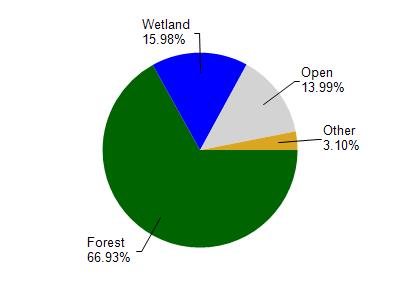Vilas
No
No
Yes
Fish and Aquatic Life
Overview
Big Arbor Vitae Lake, in the Upper Tomahawk River Watershed, is a 1,070.33 acre lake that falls in Vilas County. This lake is managed for fishing and swimming and is currently considered impaired.
Date 2016
Author Ashley Beranek
Historical Description
Source: 1963, Surface Water Resources of Vilas County
Arbor Vitae (Big) Lake, T-40-N, R-7-E, Sections 19, 20, and 30,
Area = 1,065 Surface Acres, Maximum Depth = 36 feet
Big Arbor Vitae is a drainage lake of high fertility. It has
alkaline clear water of low to moderate transparency depending
somewhat on algal response to the lake's fertility. Sand andgravel
are the most important components of the bottom types but muck is
present in significant amounts. It is a muskellunge-walleye fishing
lake and bass are also an abundant game fish. Muskrats are a
significant fur bearer and the lake shore is used for a nesting
site by various waterfowl. Aesthetic value of a lake this large is
excellent because of the large amount of with public frontage.
Public use opportunities are excellent; in addition to a state boat
landing and picnic area on the north shore and a town landing on
the south side with access possible from State Highway 70 with
nearby parking, there are 14 resorts on the lake and boat rental
facilities as well.
Date 1963
Author Surface Water Inventory Of Wisconsin
Impaired Waters
Big Arbor Vitae Lake was assessed for phosphorus and algae every two-year cycle from 2016 to 2022; impairments of excess algal growth and phosphorus were first found in cycles 2016 and 2018, respectively, and confirmed in the subsequent cycles.
Date 2022
Author Ashley Beranek
Condition
Wisconsin has over 84,000 miles of streams, 15,000 lakes and milllions of acres of wetlands. Assessing the condition of this vast amount of water is challenging. The state's water monitoring program uses a media-based, cross-program approach to analyze water condition. An updated monitoring strategy (2015-2020) is now available. Compliance with Clean Water Act fishable, swimmable standards are located in the Executive Summary of Water Condition in 2018. See also the 'monitoring and projects' tab.
Reports
Recommendations
Data analysis, report production
Lake Management Plan Development
Water Quality Modeling
Shoreland Monitoring, Assessment, Inventory
Shoreland Monitoring, Assessment or Inventory
Develop/Distribute Newsletter
Lake Management Plan Development
Watershed Mapping or Assessment
Management Goals
Wisconsin's Water Quality Standards provide qualitative and quantitative goals for waters that are protective of Fishable, Swimmable conditions [Learn more]. Waters that do not meet water quality standards are considered impaired and restoration actions are planned and carried out until the water is once again fishable and swimmable
Management goals can include creation or implementation of a Total Maximum Daily Load analysis, a Nine Key Element Plan, or other restoration work, education and outreach and more. If specific recommendations exist for this water, they will be displayed below online.
Monitoring
Monitoring the condition of a river, stream, or lake includes gathering physical, chemical, biological, and habitat data. Comprehensive studies often gather all these parameters in great detail, while lighter assessment events will involve sampling physical, chemical and biological data such as macroinvertebrates. Aquatic macroinvertebrates and fish communities integrate watershed or catchment condition, providing great insight into overall ecosystem health. Chemical and habitat parameters tell researchers more about human induced problems including contaminated runoff, point source dischargers, or habitat issues that foster or limit the potential of aquatic communities to thrive in a given area. Wisconsin's Water Monitoring Strategy was recenty updated.
Grants and Management Projects
Monitoring Projects
| WBIC | Official Waterbody Name | Station ID | Station Name | Earliest Fieldwork Date | Latest Fieldwork Date | View Station | View Data |
|---|
| 1545600 | Big Arbor Vitae Lake | 643050 | Big Arbor Vitae Lake - Deep Hole | 9/5/1979 | 8/15/2025 | Map | Data |
| 1545600 | Big Arbor Vitae Lake | 10042121 | Big Arbor Vitae Lake (E1) | 6/25/2014 | 2/23/2015 | Map | Data |
| 1545600 | Big Arbor Vitae Lake | 10018777 | Big Arbor Vitae Lake -- Boat Launch | 6/2/2007 | 8/15/2025 | Map | Data |
| 1545600 | Big Arbor Vitae Lake | 10005958 | Big Arbor Vitae | 5/2/1997 | 12/1/2025 | Map | Data |
| 1545600 | Big Arbor Vitae Lake | 10007671 | Big Arbor Vitae Lake -- Boat Landing At Big Arbor Vitae Dr | 7/9/1997 | 8/19/2025 | Map | Data |
|

Watershed Characteristics
Big Arbor Vitae Lake is located in the Upper Tomahawk River watershed which is 186.83 mi². Land use in the watershed is primarily forest (67%), wetland (16%) and a mix of open (14%) and other uses (3.10%). This watershed has 139.00 stream miles, 17,609.90 lake acres and 20,470.21 wetland acres.
Nonpoint Source Characteristics
This watershed is ranked High for runoff impacts on streams, High for runoff impacts on lakes and Low for runoff impacts on groundwater and therefore has an overall rank of Low. This value can be used in ranking the watershed or individual waterbodies for grant funding under state and county programs.However, all waters are affected by diffuse pollutant sources regardless of initial water quality. Applications for specific runoff projects under state or county grant programs may be pursued. For more information, go to surface water program grants.